Tu sei qui
2_ES Lab_6 Solar Radiation in Via degli Antamoro ( zona Pisana )
PROCEDIMENTO
PROCESS
1- Come prima cosa creare il terreno, facendo un blocco solido sotto gli edifici.
1- First, create the ground, making a solid block under the buildings.

2- Aggiungere i dettagli più significativi agli edifici ( finestre, balconi, sporgenze, rientranze), in particolare quelli che possono modificarne l'ombreggiamento. Per fare ciò, cliccare sul solido da modificare e poi su "Edit in place"; quindi disegnare la forma desiderata e poi cliccare su "Create form"; scegliere "Solid form" se la forma deve sporgere dall' edificio, oppure " Void form" se la forma è invece una rientranza dell' edificio.
2- Add the most significant details to the buildings ( windows, balconies, projections, recesses ) , in particoular the ones that can modify the shading. To do this, click on the solid that you want to modify and then click on " Edit in place"; then draw the shape you want and click on "Create form". Choose " Solid form" if the shape protrudes from the building, or "Void form" if the shape is a recess of the building.
3- Procedere all' analisi della radiazione solare, quindi cliccare su Analize > Solar radiation. Scegliere il periodo dell' anno a cui si è interessati ed eseguire l'analisi della radiazione solare selezionando gli edifici e il terreno.
3- Proceed to analyse the solar radiation, so click on Analyze > Solar Radiation. Choose the buildings in which you are interested and make the analysis of the solar radiation, selecting the buildings and the ground.
ANALISI
ANALYSIS
Come primo passo ho selezionato tutti gli edifici appartenenti al mio condominio ed ho analizzato la radiazione solare in estate e in inverno, in modo particolare della mia palazzina.
Per quanto riguarda gli edifici circostanti ho potuto notare come , nonostante gli edifici siano simili tra loro, la variazione di orientamento porta delle differenze evidenti tra le palazzine.
L' edificio B ad esempio è leggermente ruotato verso Est rispetto all'edificio A.
ANALISI DELLA RADIAZIONE SOLARE IN INVERNO ( 21/12 - 22/3 dall' alba al tramonto )
WINTER SOLAR RADIATION ANALYSIS ( 21/12 - 22/3 from sunrise to sunset )
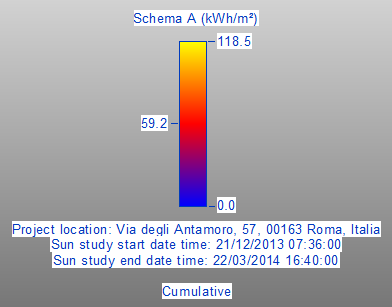
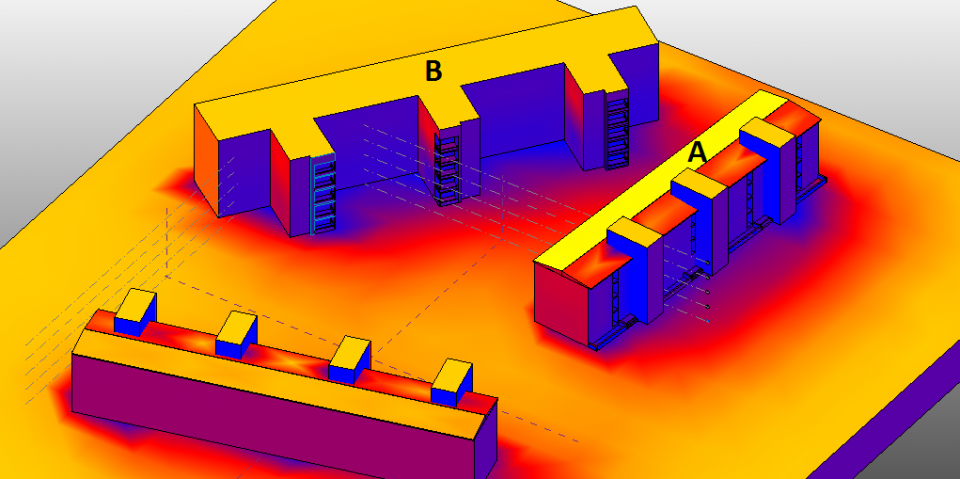
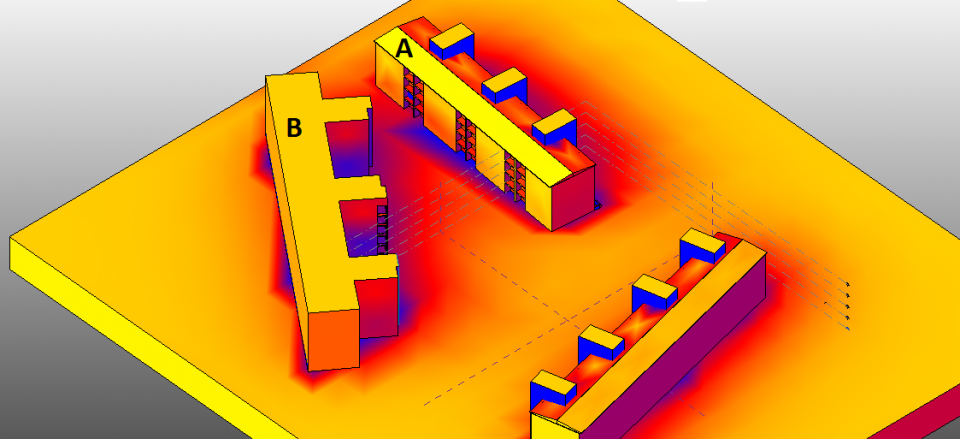
EDIFICIO A:
Ho analizzato in particolare le facciate Nord e Sud, in quanto sono le uniche facciata che presentano rientranze e sporgenze che facciano ombra sull' edificio.
Facciata Nord: La radiazione solare è molto scarsa, quindi la facciata risulta poco soleggiata e di conseguenza poco illuminata. Lo stesso terreno adiacente la facciata, ricevendo ombra dall' edificio, risulta essere poco irradiato. Non a caso, su questa facciata sono disposte le stanze serventi e una camera da letto che è infatti la più fredda della casa. Solamente il tetto risulta colpito dalla radiazione solare, che verrà quindi percepita come positiva in inverno da chi abita all' ultimo piano.
Facciata Sud: Questa facciata, al contrario della facciata Nord, riceve una grande quantità di radiazione solare ed è quindi molto più illuminata. La zona giorno della casa è infatti esposta a Sud, come anche le altre camere e in inverno queste stanze sono le più confortevoli. Il terreno adiacente la facciata risulta quasi del tutto irradiato e quindi i giardini adiacenti alla facciata sono ben soleggiati.
EDIFICIO B:
Facciata Nord-Est: la radiazione solare è quasi nulla, fatta eccezione per i piani alti delle torrette che sporgono dall'edificio, che invece ricevono una quantità media di radiazione.
Facciata Sud-Ovest: la radiazione solare investe totalmente la facciata raggiungendo un valore massimo.
BUINLDING B
ANALISI DELLA RADIAZIONE SOLARE IN ESTATE: ( 21/06 - 10/09 dall' alba al tramonto )
SUMMER SOLAR RADIATION ANALYSIS : ( 21/06 - 10/09 from sunrise to sunset )
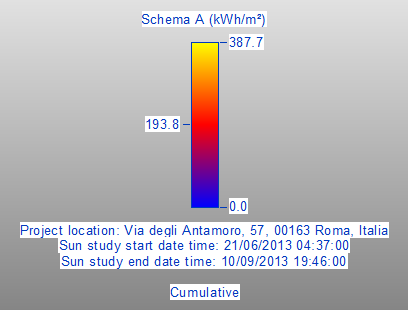
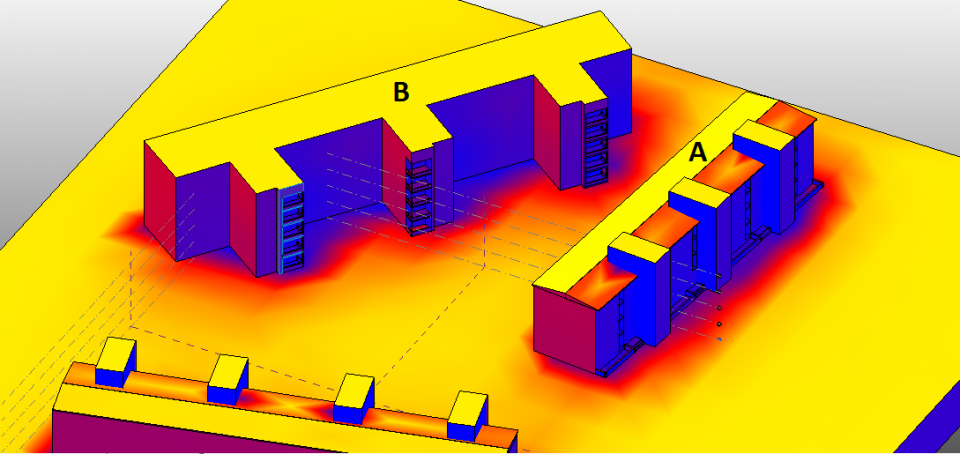
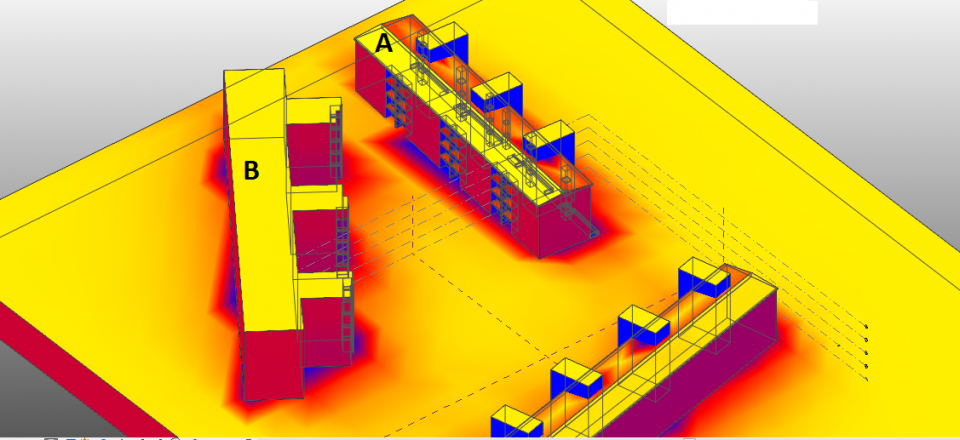
EDIFICIO A
Facciata Nord : Anche in estate su questa facciata la radiazione solare risulta essere quasi nulla, e questo porta sicuramente beneficio all' interno dell' edificio che si mantiene sempre fresco anche nei mesi più caldi. A trarre beneficio di questo scarso irraggiamento a Nord è soprattutto chi abita all' ultimo piano perchè ciò compensa il calore proveniente dalla radiazione che investe il tetto.
Facciata Sud: Nonostante la facciata sia esposta a Sud, la radiazione solare su questa facciata non è eccessiva. Le stanze più calde in estate sono sicuramente quelle esposte a Sud ma, in particolare chi abita a piano terra, non risente dell' irraggiamento in modo eccessivo.
BUILDING A
EDIFICIO B
Facciata Nord-Est: la facciata è ancora completamente priva di radiazione solare, se non per i lati delle torrette che sono invece colpiti da essa.
Facciata Sud-Ovest: la facciata è colpita dalla radiazione solare,il cui valore è però nella media, quindi non eccessivo. Il tetto è invece il punto che accumula la maggior quantità di radiazione.
Queste differenze ci fanno notare come basta una minima rotazione di un edificio a far cambiare ( in meglio o in peggio) il benessere all'interno dello stesso.
In questo caso, credo che ( soprattutto in inverno ) nell' edificio B le stanze orientate a Nord-Est siano più confortevoli rispetto a quelle della mia palazzina (edificio A) perchè accumulano un minimo di radiazione che può rendere gli ambienti meno freddi.
Dopodichè ho analizzato i giorni invernali più freddi a Roma , ossia la fine di gennaio ( 20/1 - 30/1 ), per vedere come cambia la quantità di radiazione.
Facciata Nord: la quantità di radiazione è quasi nulla, come nell' analisi invernale
Facciata Sud: la quantità di radiazione è leggermente inferiore a quella dell' analisi invernale
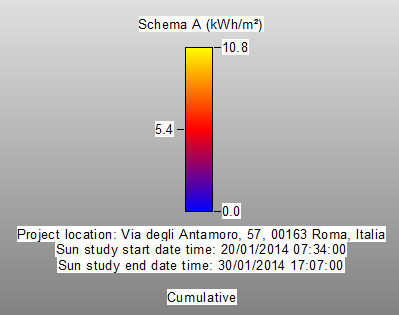
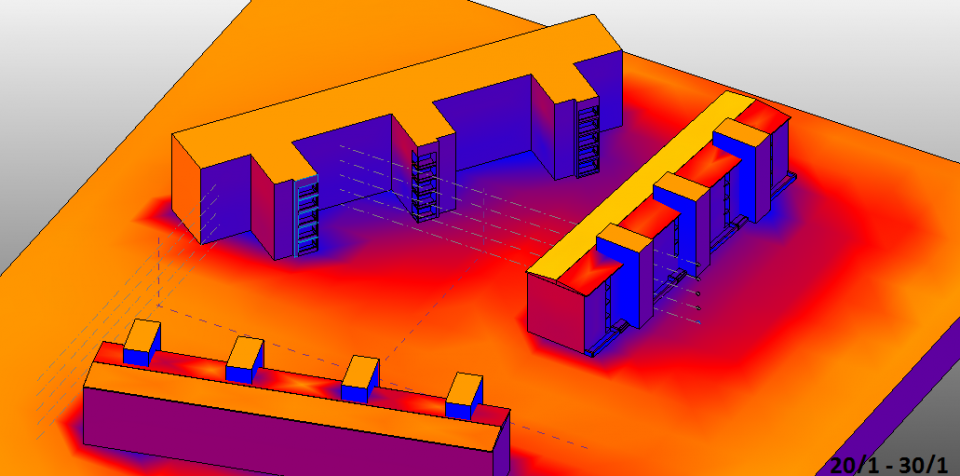
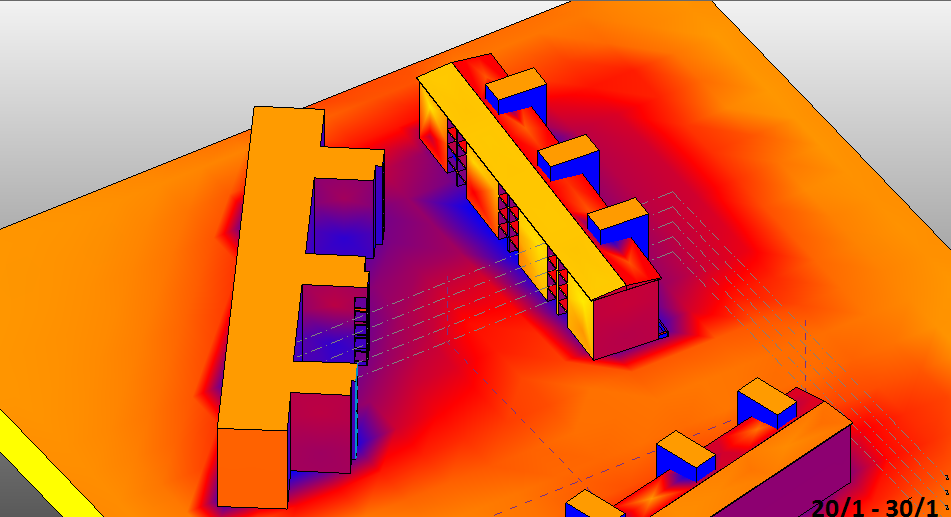
Ho inoltre analizzato le due facciate nei giorni più caldi dell' anno a Roma , ossia gli ultimi di luglio ( 20/07 - 31/07 )
Facciata Nord: la quantità di radiazione resta invariata rispetto all' analisi estiva
Facciata Sud: il livello di radiazione solare raggiunge i 61,6 kWh/m^2. Se paragoniamo questo valore ( cumulativo di dieci giorni) ai 387,7 kWh/m^2 dell'analisi estiva ( cumulativa di circa 3 mesi ) ci accorgiamo che il valore cumulativo di questi giorni di luglio è effettivamente molto alto.
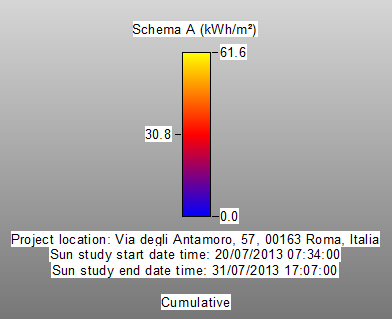
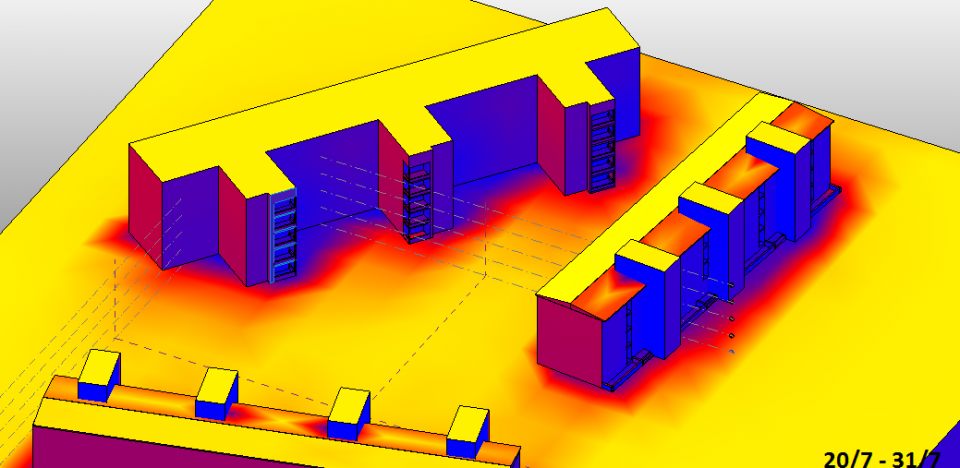
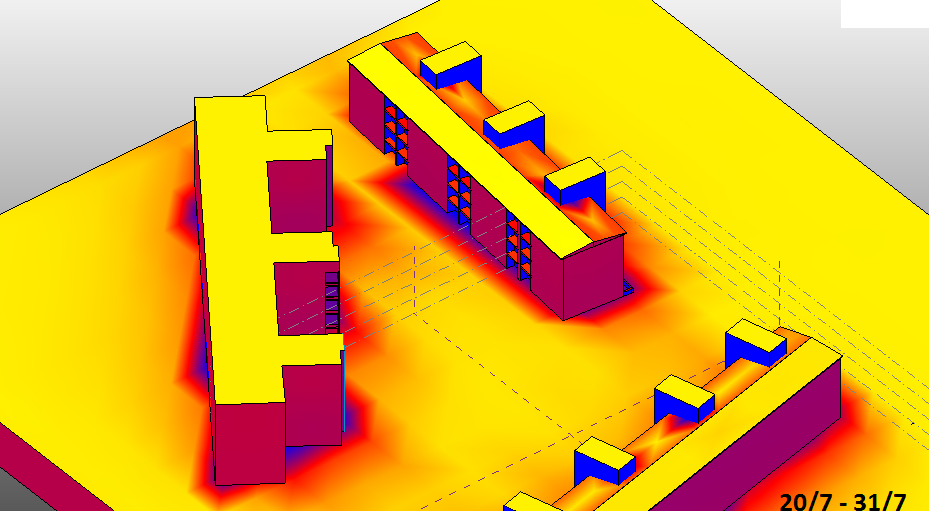
Infine, ho analizzato il degrado di alcuni elementi della facciata Nord, studiando il comportamento della radiazione solare sia in inverno che in estate. Siccome questa facciata, sia in estate che in inverno, accumula una piccolissima quantità di radiazione solare, vi sono vari punti in cui ciò è evidente perchè si ha la formazione di muffa, il degrado dell'intonaco, e la formazione di macchie sulla cortina di facciata.
Finally, I analyzed the degradation of some elements of the North face, studying the behaviour of the solar radiation in winter and in summer. As this front, both in summer and in winter, accumulates a small amount of solar radiation, there are several points where this is evident because you have mold, deterioration of the plaster, and the stains on the curtain facade.
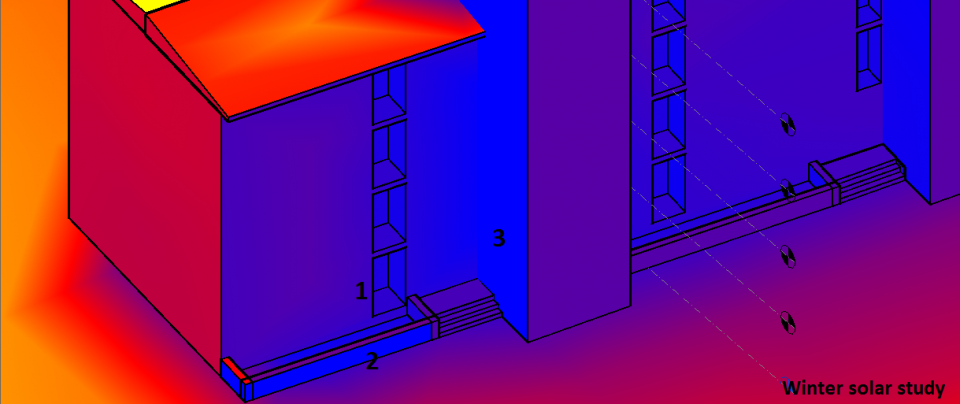
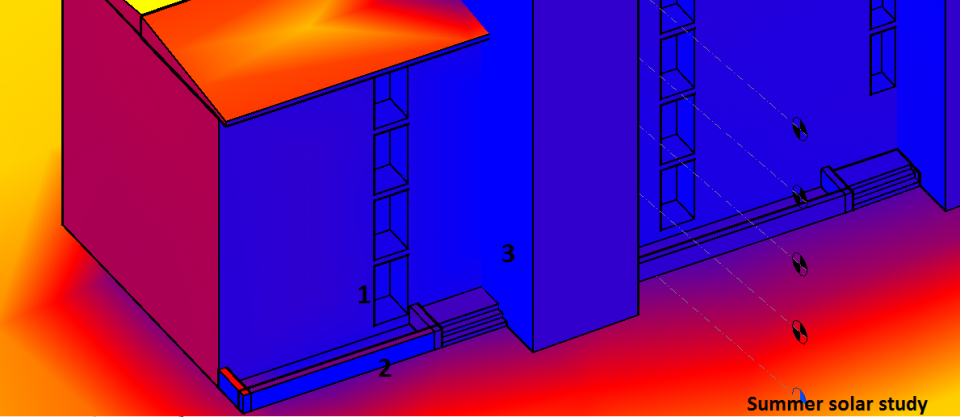
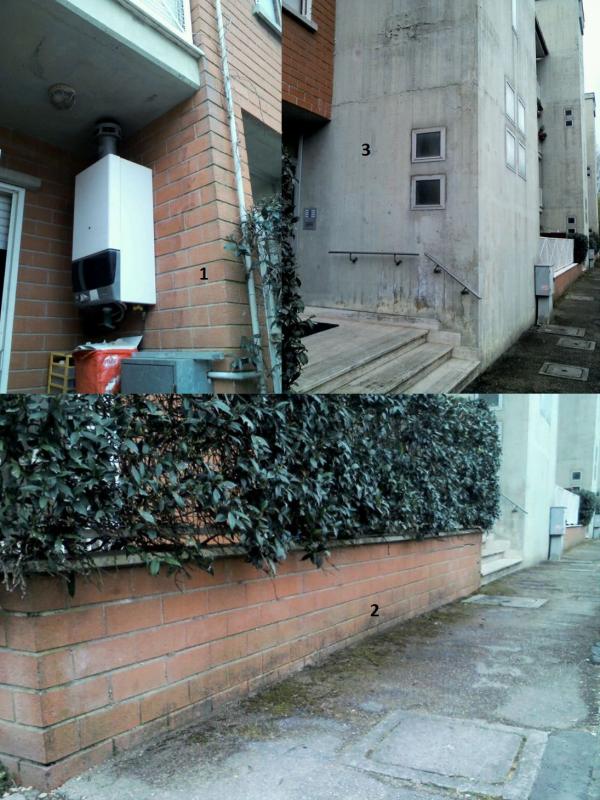
Analizziamo le immagini nel dettaglio.
Dettaglio 1: il balconcino consiste in una rientranza di 1,3 metri nella facciata, quindi non è mai colpito dalla radiazione solare. Questo è evidente dal colore più scuro che si può notare man mano che si va verso l'interno. Si può notare proprio una linea diagonale che separa la parte di cortina più chiara ( dove batte il Sole ) da quella più scura ( sempre in ombra ).
Dettaglio 2: Il muretto del piccolo cortile adiacente alla facciata è caratterizzato dalla presenza di muffa e di vegetazione dovute al fatto che in quel punto non si ha quasi mai una radiazione diretta.
Dettaglio 3: La torretta ( corpo scala ) che sporge dalla facciata presenta un forte degrado dell' intonaco in quanto, in particolare ai lati, non riceve radiazione diretta.
Mi scuso per il ritardo nel consegnare ma ho avuto problemi con la Solar Analysis in quanto il tasto corrispondente su Vasari risultava grigio e quindi inattivo.

Commenti
Interesting context
... looking forward to it!
courtyard and buildings similar but different orientations...